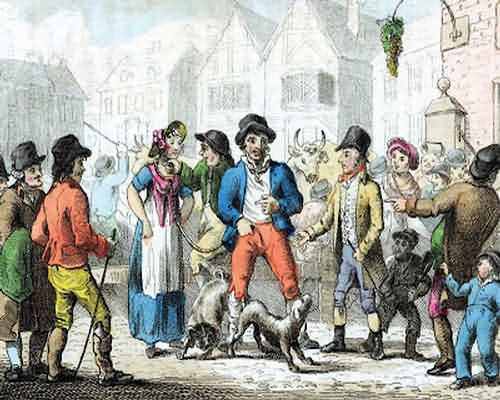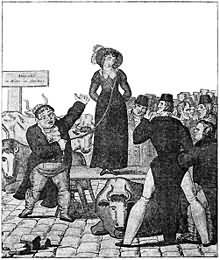 |
| The Local Time is Saturday, 27-Jul-2024 07:24:11 CEST |
Wife Selling |
|
|||
| YOU ARE HERE: Main Home Page > Strange Things > Wife Selling |
|
|
 |
|||||||||||||||||||||||||||||||||||||||||||||||||||||||||||||
Wife selling in England was a way of ending an unsatisfactory marriage by 'mutual' and 'not so mutual' agreement began in the late 17th century, when divorce was a practical impossibility for all but the very wealthiest. At todays prices the equivalent cost of obtaining a divorce in those days would be £20,000.00. After parading his wife at a public market place with a halter around her neck, arm, or waist, the husband would publicly auction her to the highest bidder, often using the services of an auctioneer.
The widespread belief that a man could legally divorce his wife by putting a halter around her neck and leading her to be sold in the marketplace on a fair day. In some cases this was a relatively civilized arrangement between the husband, wife and her lover, all three meeting amicably afterwards for a drink. In other cases the wife would be ‘sold’ to a total stranger for the highest bid.. The practice of 'wife selling' was not strictly legal but became popular among the poor as a remedy to a bad marriage. In the early days the legal authorities turned a blind eye. The practice became more unpopular in its latter stages and was increasingly stamped down on by the the courts and could involve upto 6 months in prison. Some cases of Wife SellingChipping NortonThe practice went on in rural areas as late as the mid-nineteenth century. In 1855, at GloucesterIn 1760 Gloucestershire magistrates heard the case of a woman who had married in the 1740s. She and her husband did not take long to part by means of a wife sale in Gloucester. Her new husband was a coal miner, Nicholas Read, who took her to Bath, where they were married "by one parson Crey, a lawless minister there." BirminghamThe first recorded instance of an exchange of money for releasing a husband from the obligations of his marriage comes from Bilston (near Wolverhampton, Birmingham), in the 1690s, when "John son of Nathan Whitehouse of Tipton, sold his wife to Mr Bracegirdle." Not long afterwards a man was presented in the Thame church court for cohabitation with another's wife. During the proceedingss it came out that he had "bought another's wife" off her husband at 21/4 pence the pound." By the early eighteenth century, references to wife sales were finding their way into the press. The Annual Register carried the following account in August 1733. "Three men and three women, went to the Bell Inn in Edgbaston-street, Birmingham, and made the following entry in the toll book which is kept there:-
CanterburyIn 1820 a 'decent-looking man' led his erring wife into the cattle market of Canterbury and when the autioneer refused to auction her first he hired a cattle pen to keep her in until she was eventually auctioned for five shillings (25 pence in todays money). Not restricted to the poorer classesHenry Brydges, 2nd Duke of Chandos, MP (17 January 1708 – 28 November 1771), known from 1727 to 1744 by his courtesy title Marquess of Carnarvon, The Duke of Chandos and a companion dined at the Pelican, Newbury, on the way to London. A stir in the Inn yard led to their being told that a man was going to sell his wife, and they are leading her up with a halter around her neck. They went to see. The Duke was smitten with her beauty and patient acquiescence in a process which would (as then supposed) free her from a harsh and ill-conditioned husband. He bought her, and subsequently married her. |
|||||||||||||||||||||||||||||||||||||||||||||||||||||||||||||
| BACK TO TOP | |||||||||||||||||||||||||||||||||||||||||||||||||||||||||||||
|
|||||||||||||||||||||||||||||||||||||||||||||||||||||||||||||
Wife Selling |
|||||||||||||||||||||||||||||||||||||||||||||||||||||||||||||
| This page last modified Thursday, 11-Feb-2021 13:25:13 CET | |||||||||||||||||||||||||||||||||||||||||||||||||||||||||||||
 Wife selling persisted in England in some form until the early 20th century; according to the jurist and historian James Bryce, writing in 1901, wife sales were still occasionally taking place during his time. In one of the last reported instances of a wife sale in England, a woman giving evidence in a Leeds (city in West Yorkshire) police court in 1913 claimed that she had been sold to one of her husband's workmates for £1.
Wife selling persisted in England in some form until the early 20th century; according to the jurist and historian James Bryce, writing in 1901, wife sales were still occasionally taking place during his time. In one of the last reported instances of a wife sale in England, a woman giving evidence in a Leeds (city in West Yorkshire) police court in 1913 claimed that she had been sold to one of her husband's workmates for £1.